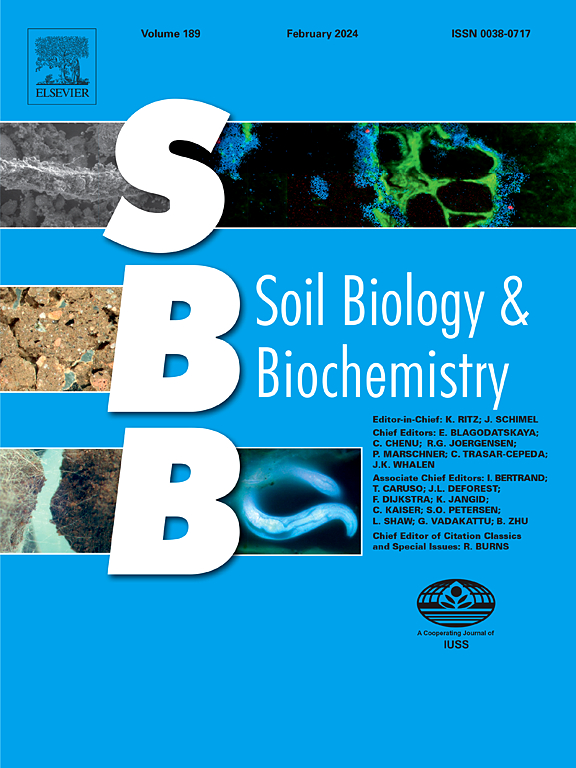原生入侵者的土壤遗产强烈地驱动了系统发育上距离较远的物种的次生入侵
IF 9.8
1区 农林科学
Q1 SOIL SCIENCE
引用次数: 0
摘要
入侵植物物种可以改变土壤的非生物和生物特性,有些变化在原初入侵者被消灭后仍会持续很长时间。然而,土壤遗产如何影响初次入侵后的次生入侵尚不清楚,这阻碍了有针对性的控制和清除后管理策略的发展。以加拿大一枝黄花(Solidago canada)为主要入侵植物,建立了5种田间土壤调节处理:对照(裸地)、入侵处理(未管理的入侵地)和3种管理处理(通过刈割、施用除草剂或焚烧管理的入侵地)。随后,我们在温室环境中评估了9对次生入侵者和原生同系物在这些条件土壤中的反应。结果表明,一枝黄花入侵降低了土壤速效氮、磷、钾等养分含量,增加了土壤病原菌多样性。虽然这些土壤遗产减少了次生入侵者和原生同系物的生长,但它们不成比例地增强了次生入侵者的生物量优势,导致了次生入侵的倾向。与未经管理的入侵样地相比,刈割没有进一步改变土壤性质,施用除草剂和焚烧对土壤病原体多样性没有影响,但显著增加了土壤有效养分。因此,刈割对次生入侵没有影响,而施用除草剂和焚烧处理增加速效养分削弱了次生入侵的强度。值得注意的是,与一枝黄花亲缘关系较远的次生入侵者从土壤遗产中获益更多,与管理方法无关。这些结果强调了土壤遗产效应在促进次生入侵中的作用,并强调了与主要入侵者的系统发育距离是决定次生入侵成功的关键因素。本文章由计算机程序翻译,如有差异,请以英文原文为准。
Soil legacies of a primary invader strongly drive secondary invasions for species that are phylogenetically distant
Invasive plant species can alter soil abiotic and biotic properties, with some changes persisting long after the primary invader's eradication. However, how soil legacies will influence secondary invasions following control of primary invaders remains unclear, hindering development of targeted control and post-removal management strategies. We used Solidago canadensis as the primary invader and established five field soil conditioning treatments: control (bare plots), invasion treatment (unmanaged invaded plots), three management treatments (invaded plots managed by cutting, herbicide application or burning). Subsequently, we assessed responses of nine pairs of secondary invaders and native congeners in these conditioned soils within a greenhouse setting. We found that Solidago invasion decreased soil nutrients including available nitrogen, phosphorus and potassium and increased soil pathogen diversity. While these soil legacies reduced the growth of both secondary invaders and native congeners, they disproportionately enhanced the biomass advantage of secondary invaders, resulting in a predisposition to secondary invasions. Compared to unmanaged invaded plots, cutting did not further modify soil properties, and both herbicide application and burning had no effect on soil pathogen diversity but strongly increased soil available nutrients. Consequently, cutting had no impact on secondary invasions, while increased available nutrients in herbicide application and burning treatments weakened the intensity of secondary invasions. Notably, secondary invaders distantly related to Solidago benefited more from soil legacies, irrespective of management method. These results underscore the role of soil legacy effects in facilitating secondary invasions and highlight phylogenetic distance from the primary invader as a crucial factor in determining secondary invader success.
求助全文
通过发布文献求助,成功后即可免费获取论文全文。
去求助
来源期刊

Soil Biology & Biochemistry
农林科学-土壤科学
CiteScore
16.90
自引率
9.30%
发文量
312
审稿时长
49 days
期刊介绍:
Soil Biology & Biochemistry publishes original research articles of international significance focusing on biological processes in soil and their applications to soil and environmental quality. Major topics include the ecology and biochemical processes of soil organisms, their effects on the environment, and interactions with plants. The journal also welcomes state-of-the-art reviews and discussions on contemporary research in soil biology and biochemistry.
 求助内容:
求助内容: 应助结果提醒方式:
应助结果提醒方式:


